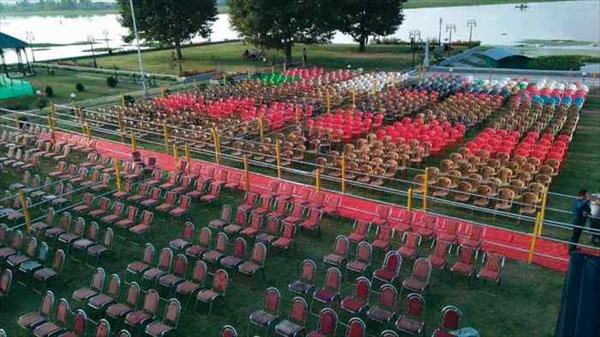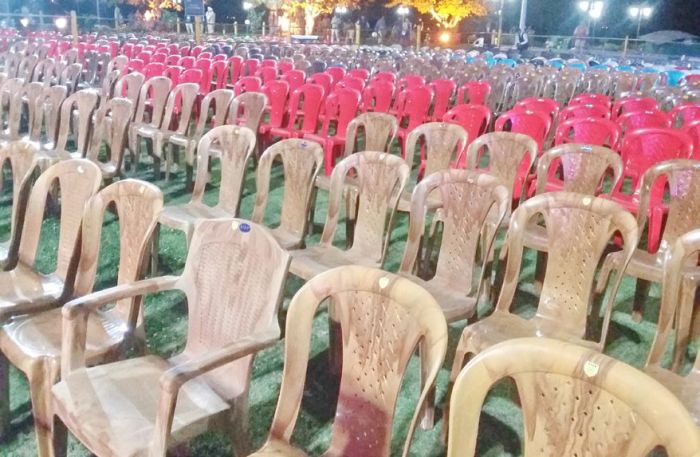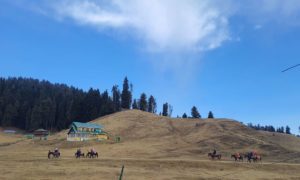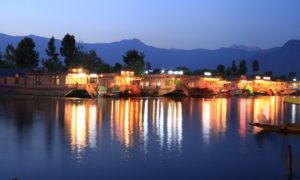Using Music for politics, this fall, the Indian musicians arrived in the security-ringed SKICC to entertain a select few, while the Shikara wallas at Ghat No. 27 were just leading another day of hardship. The concert sounded anything but a hope of revival for their business which is suffering.
It was a typical October evening with mild sunshine over the misty Dal Lake. The otherwise meditative lake was reverberating with the sounds of live music, blaring from the concert of Lucky Ali, a celebrated singer from the mainstream Indian Pop music, performing live at SKICC.
Ali was the second prominent Indian musician to perform in the state-managed convention centre after Adnan Sami’s performance at the same venue on October 7. While Ali’s concert was organised by the army in the name of a Youth Mela, Sami’s was sponsored by J&K Tourism ‘in a bid to boost tourist footfall in the Valley’.
Usually music concerts of well-famed musicians bring scenes of long queues of music aficionados and joyous faces of attendees, but Kashmir always comes with its unique distinctions. Here, the use of Music too has politics involved, and fails to move the mood beyond the “security” that cages natives in an effort to bring tourists.
Sami and Ali failed to recreate the madness, which was last seen when Pakistan’s Junoon Band was given a rousing reception in Srinagar.
It was a Friday, most of the areas from the downtown were under curbs and the community as of whole was under constant distress due to the recent braid-chopping incidents. Boulevard Road looked more like an abandoned site.
A few kilometres away from the concert venue was the deserted Ghat No. 27, the last bank near the famous Nishat gardens. On the stairs of this ghat sat a group of four men, who were Shikara owners and operated from this ghat.

“We used to have 25 Shikaras lined at this ghat,” said Ghulam Rasool, who has been running his Shikara through this ghat from the past 20 years. “But now it has come down to 5 Shikaras. Such is the downfall of the sales from visiting tourists.”
The group seemed to be highly agitated by the sound coming from that particular concert going on at SKICC. It turned out, none of them was a music hater or a conservative person opposing such event. Rather the concern of their abhorrent state was the downfall in their Shikara business and government’s complete ignorance towards addressing their basic issues.
In the peak season, they said, the daily average earning was anything between Rs 1000 and 5000. But these days, they hardly earn anything between Rs 100 and 200, thus making it difficult for them to make ends meet.
“I visited the Tourist Reception Centre in June to renew my Shikara license,” one of the Shikara owners said. “There I got to know that a package is about to be released for the Shikara owners whose business has suffered a setback due the downfall in tourism. But till today, we’re yet to receive it.”
By the time the noise of a second concert held in the same month of October began reaching Ghat No. 27, most of the Shikara wallas were tad upset. Many of them had only earned Rs 100 note in last three days.
Bewildered and somewhat infuriated, they questioned the government’s much-hyped resolve to address tourism-related issues.
Kashmir is an all-weather and all-season tourist place and tagging its tourism specifically around the Dal Lake region as summer-based would be an understatement. Addressing the decline of tourism in Srinagar during the winters specifically as a reason of seasonal change would be a wrong assessment of the issue. Comparatively, the other neighbouring states are doing well. Himachal Pradesh, for example, is successfully running its tourism round the year.

The tough economic state of the Shikara owners at some particular Ghats is a reason of monopoly by brokers who are the travel agents involved in the pre-booking system. While the volatile political scenario is an apparent disruption, the Darbar Move in October further creates a managerial crises for Kashmir tourism.
Amid all this, the state and its allied managers might be using concert celebrities as tourism mascots, but the persistent gloom at Ghat No. 27 only scorns at such events, desperately tried by Tourism Department to pull off certain moves to improve the tourism footfall in Kashmir.
But are these tools effective enough or just gimmicks? What’s the real connotation of tourism in Kashmir? How does the government of this state perceive the tourism sector? Is tourism just a means to weave an image of Kashmir devoid from its real and crucial issues which suits the interests of the state? Or is tourism a means of generating employment and income for those involved in this particular sector of our economy?
While these events may seem like fine efforts to revive tourism, but on the ground level concerts, youth Melas, Shikara races, video campaigns seem to be inefficient in addressing those issues that can improve the livelihood and conditions of those associated with this particular economic sector.
While it’s said that the estimate budget of the recent Adnan Sami concert was around Rs 1 crore, the Shikara owners at Ghat No. 27 are still perturbed about how to pay their children’s school fees and are planning to switch to other means of earning.
Ali Saffudin is a musician from Kashmir who blends Kashmiri Sufi music with songs of protests and dissent. You can follow his music here.








